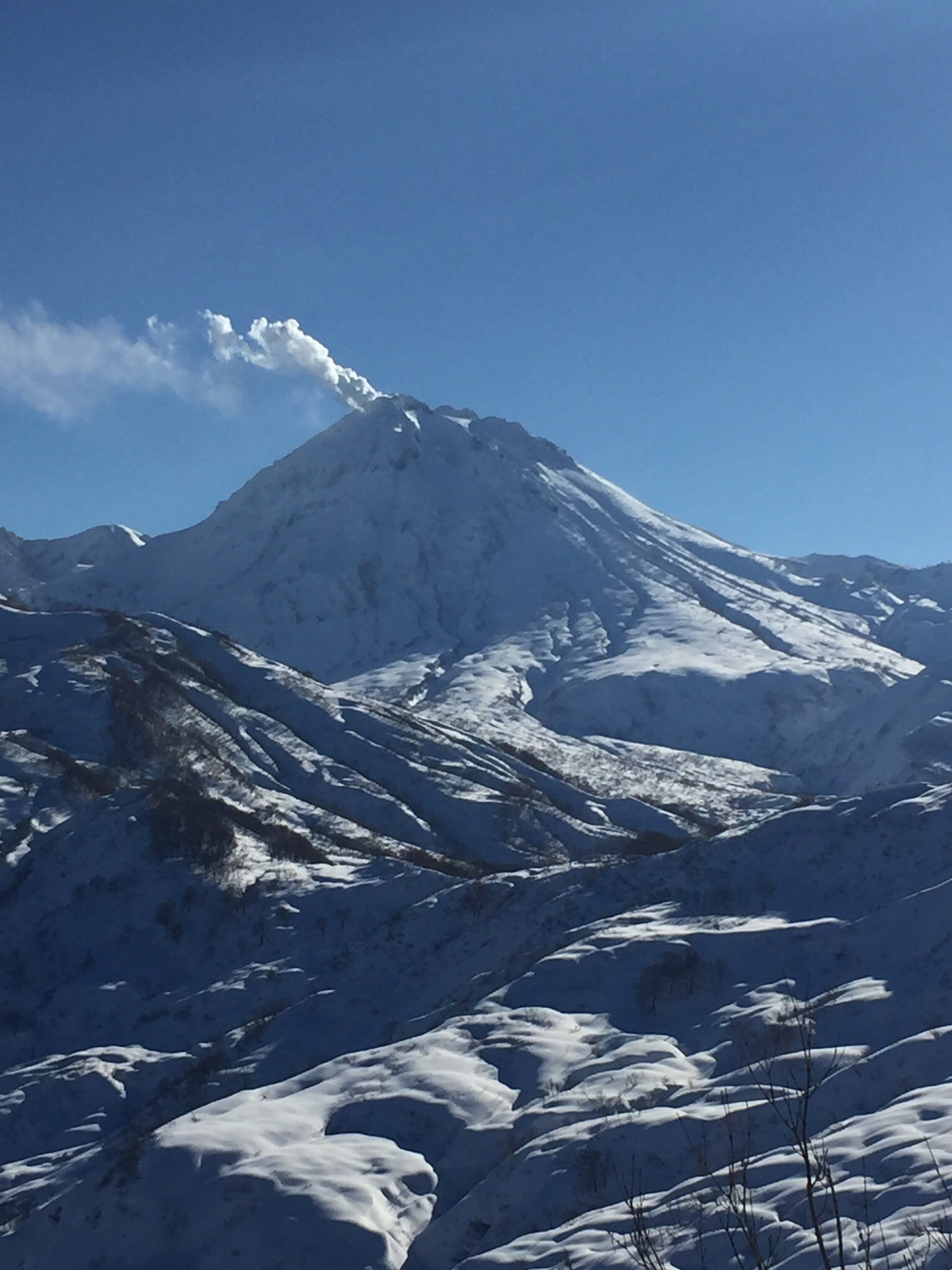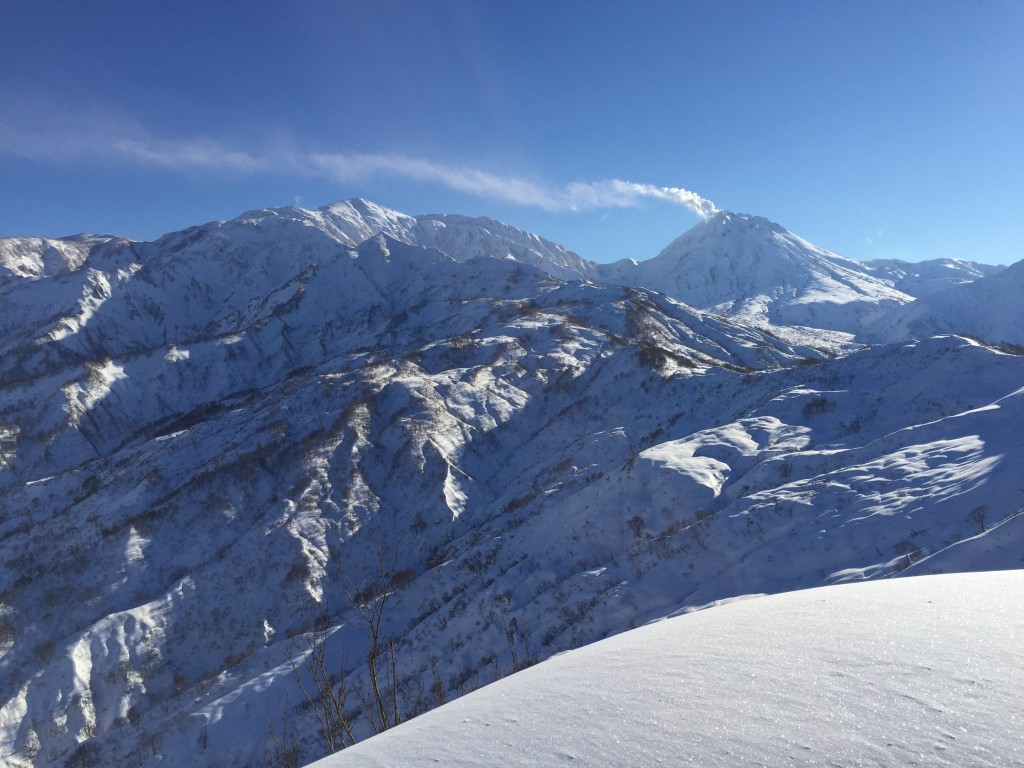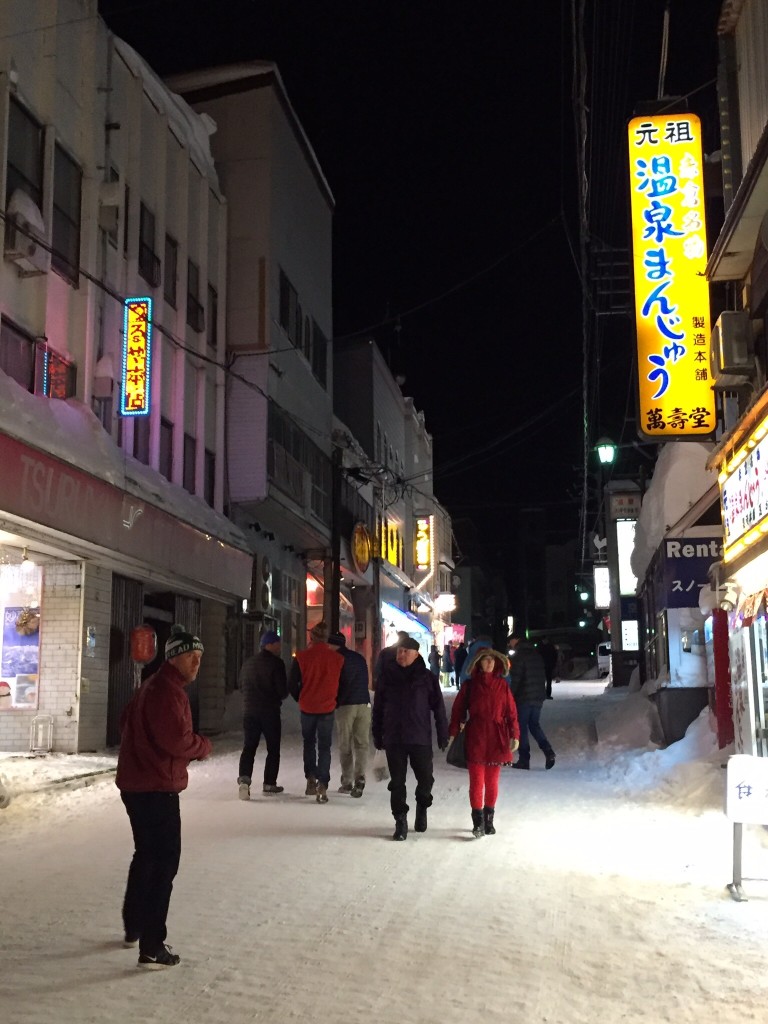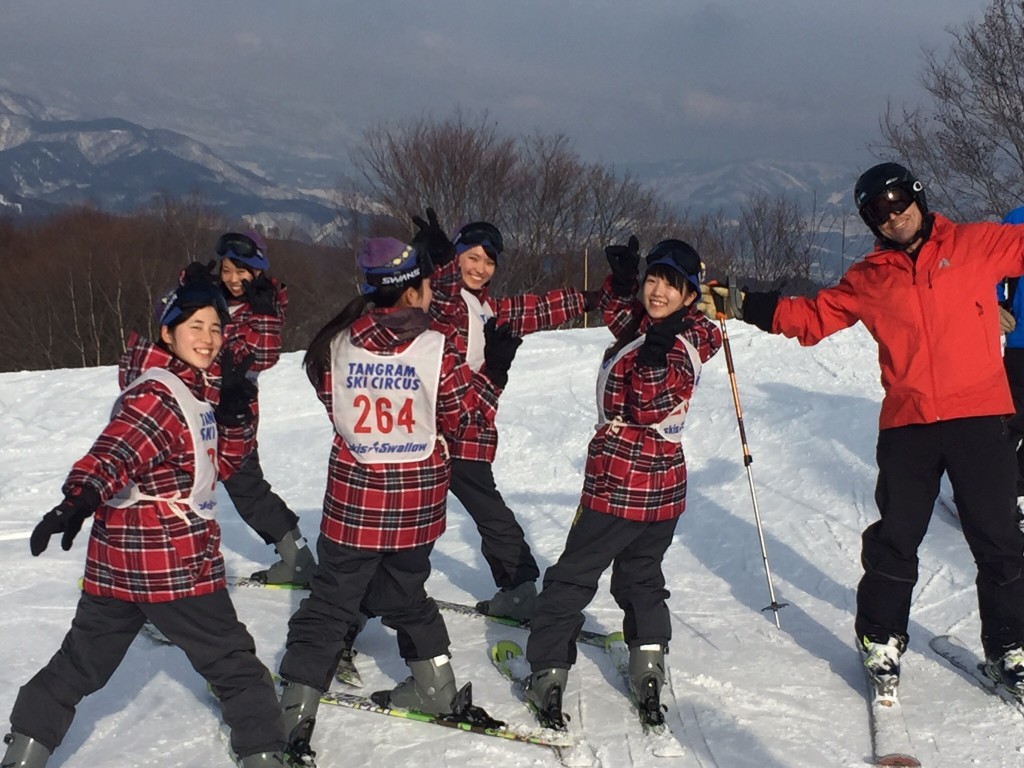In the Japan Alps, daunting terrain culminates in a smoldering volcano. (John Briley)
This article originally appeared in the Washington Post.
By John Briley
You don’t have to go to Japan to ski, eat sushi and soak in geothermal hot springs. But if you want deep powder without lift lines for $40 a day, the best sushi and ramen in the world in intimate, family-run restaurants and a naked soak in a 105-degree spring with a view of the volcano that is heating your water, in the comfort of your hotel, then follow the drifting snowflake to the Land of the Rising Sun.
I am thinking this as I sit in the bustling lodge at a two-lift ski area called Seki Onsen, picking tunes on a public guitar that I pulled from the wall, with the melting vestiges of a 15-inch powder day still dripping from my boots. I am surrounded by friends and strangers eating noodle soup and drinking beer.
Seki Onsen is the smallest of six ski areas that hug the lower flanks of Mount Myoko, an active volcano 175 miles northwest of Tokyo that juts, like a clenched fist, 8,051 feet into the sky. In one week here we will ski five of those areas, plus two of the other 16 ski resorts that sit within an hour’s drive. (The word onsen, which means hot springs, is used liberally as a noun and verb in the many parts of Japan where such waters burble forth.)
Ten buddies and I have come from all over the United States to Akakura Onsen, a village in the highlands surrounding the city of Myoko, in late January, hoping to tap a powder spigot renowned among committed skiers. In a normal winter, cold fronts pulse down from Siberia, suck moisture off the Sea of Japan and spiral ashore, dumping up to 650 inches of snow per season on the mountains here on Honshu and the northern island of Hokkaido.
This meteorological blitzkrieg is most active from December through February, a pattern that has spawned the noun “Japanuary” among powder chasers worldwide.
Alas, this isn’t a normal winter in Myoko, something we will hear often this week. From my home in Washington, I watch with increasing gloom as front after promising front fizzles offshore or rockets up to Hokkaido. The Myoko area, according to a forecast blog I am following, is having its driest winter in memory.
But hope — especially when cornered by nonrefundable reservations — springs eternal, and the dry spell breaks the night we arrive. After a partly cloudy shuttle ride from Tokyo’s Narita International Airport, we take an exit for Akakura and smack straight into winter.

Skiers and snowboarders take a lunch break at the lodge atop Charmant Hiuchi, a two-lift ski area near Itoigawa, Japan. (John Briley )
We find our way to the Morino Lodge, a three-story, Australian-owned hotel. The entire first floor is open-flow communal space, with couches, bookshelves, dining tables and a small bar manned by a lanky, bearded Scot named Paul. In the glow of Japanese microbrew, with the powder factory churning away outside, I feel the haze of 22 hours of travel start to lift. “Yoga at 6, bre-aykfast at 7,” Paul says as he taps out for the night.
Main drag, Akakura Onsen, Myoko, after a snowfall. (John Briley)
Eventually the smiling ladies at the ticket counter take a pile of yen from us, slide 11 tickets across the counter and gesture us toward the slopes. After riding one lift over dead-flat ground and another up a bunny slope, we solve the map and make our way to the top of the interconnected Akakura Kanko resort, where the new snow is more than a foot deep and still accumulating.
The Japanese, who were largely absent at the Morino Lodge, have gathered in minor force on the mountain, sticking mainly to the center of the marked runs. That leaves ample lanes of powder on the margins, and we spend the morning feasting on the new snow, bumping farther into the woods with each run.
Akakura, like most Japanese resorts, forbids off-trail skiing, a rule that many foreigners ignore. As the storm peters out I notice that we are sharing the trees with a broadening multicultural group. Someone else notices too: I emerge from the aspens after yet one more powder bash to see a strategically positioned ski patroller motioning me into a circle of worried-looking dudes. He points to my lift pass and, without a spoken word, adds it to a stack in his hand.
As we plead our cases in our native tongues, the patroller shakes his head and points up at the trees with a clear message: off limits. Just as we’re all giving up and starting to shuffle away, he calls us back and redistributes the seized passes.
I meet my friends for lunch in a small mid-mountain restaurant, where we are challenged to order and pay for the food at a wall-mounted machine — with photos and prices but no English instructions — before stepping around the corner to receive our steaming bowls of noodles and tempura from a more-familiar cafeteria line of humans.
Some resorts shut down. Others limped along in bankruptcy protection, which left little cash for on-mountain improvements. As a result there are few high-speed lifts in Japan, and some areas, including Seki, feature what are affectionately known as “pizza box” lifts — single-seat chairs with only the suggestion of a backrest. There are exceptions to this throwback vibe, notably at the bigger resorts on Hokkaido and in the Hakuba area, a two-hour drive south of Myoko.
The lack of new investment is most evident in the layout of the resorts. Too many lifts terminate just below the most alluring terrain, and I continually catch myself gazing up at chutes, glades and bowls, willing a chairlift to appear.
We find the best pitches at a burly mountain called Madarao, where 15 lifts serve 30 runs on a vertical drop of 1,500 feet, including numerous glades and a few shots of steep trees. I can see how this would be a powder hound’s paradise in a normal year, but we make the best of it by finding scraps of unsullied snow in the woods before turning to soft moguls and long, ripping groomers.
The drought, thankfully, has not impacted the food supply. We hit a different restaurant every night, most decorated in an odd mix of traditional art, yellowing ski photos and trail maps. Each is a restorative adventure, including udon noodles in black squid ink, kimchi ramen, traditional Japanese oden and, at Sushi Takasago, buttery cuts of fish and hot sake delivered by an ever-smiling matron. As we are leaving, she and her husband, who is cleaning up the sushi bar beneath a glass-cased display of 29 large, gleaming fishhooks, hands us slices of the sweetest, crispiest apple I have ever tasted. Upon realizing that half our group has already departed, the owners insist we wait while they slice up more, which they bag for us to take back to our crew.
There is no such air of aggression at the Morino where, at any given hour, about half of the guests are in bathrobes, en route to or from the onsen. These serene, indoor-outdoor sanctuaries of stone and tile are on the lower level, strategically partitioned for each gender because, under the national custom of hadaka no tsukiai (roughly, “naked friendship”) bathers must leave everything — pretense, clothing, even après-ski cocktails — in the changing rooms.
Akakura’s waters emerge from the ground at 116 degrees Fahrenheit, cool down as they collect in the village’s central tank and are typically treated, and sometimes reheated, only lightly at their final destination, Morino Lodge co-owner Craig Oldring tells me. Japan even has a law, onsenhou, stipulating the minimum temperature and mineral-content standards that springs must meet to bear the onsen label. In other words, this is not the generic, hyper-chlorinated hot tub you might recall from other ski vacations.
Sitting in the 108-degree outdoor pool with smuggled beers in hand and a moon rising over Mount Myoko, we decide that we’ll wring all we can out of these mountains, conditions be damned.
On our second day, we hire Glude and his apprentice, Mitsui, a cheerful, snowboarding son of a salaryman from Osaka, to lead us on a two-hour backcountry tour from the top of Akakura Kanko.
The same design flaw that frustrated me inbounds at the resorts makes Japan a backcountry skier’s dream, with lifts doing half the work and leaving the choicest labor — as well as views and powder shots — to those with the quads, lungs and time to march up the mountains. Many foreigners come here more for the hike-to terrain than the inbounds runs.
We zigzag through a forest of burly beech trees called bunas, which yields to an open ridge cloaked in mist.
Atop a wind-scoured peak, we look down a delightfully steep pitch of untrammeled snow falling away to the north.

A group of backcountry skiers pauses on a ridge above Akakura Onsen resort near Myoko, Japan. (John Briley )
“In a normal year . . . ” Glude sighs, and he doesn’t need to finish the sentence. We’ll be skiing back the way we came. In the United States, thin snow cover means hitting rocks. Here, it means risking a face plant by sasa vine, a bamboo derivative that grows in tangled loops and is infamous for snaring skiers. Even with the dicey conditions, we get a whisper of how good it can be, surfing a feathery quilt through the buna trees and back to the resort.
The following day we reap a richer reward.
We spend the morning bounding through 1,600-vertical-foot laps of shin-deep powder, fresh turns on every run. After a ramen break in a log cabin at the top of the lift, where a vintage 1980s Pioneer stereo system idles in a corner — a totem to a bygone era in Japan — Glude and Mitsui lead us on a short backcountry tour to one of the best views in Japan: an alpine mosaic of peaks and valleys, contours and ridges, snow, rock, trees and more snow, culminating in the smoking cone of a volcano five miles away.
On the drive back, we stop for photos of a distant Mount Myoko when movements in the woods draw our attention: snow monkeys. Two, three and suddenly dozens skitter up and down trees, swinging from branches, cautiously checking us out before darting off.
Seeing these guys in the wild wasn’t on my list, but I retroactively add it — one less thing to check off when I return during a normal winter.





Hey John ! Loved the article! Skiing in Japan has been on my radar since Warren Miller first opened my field of view to this far flung part of the world. AND who knew you and i both share KITING and SKIING as a way of experiencing the world around us!